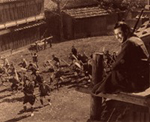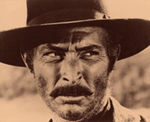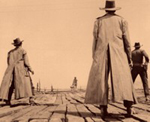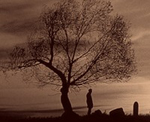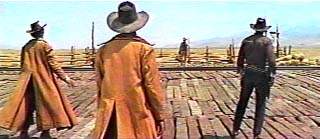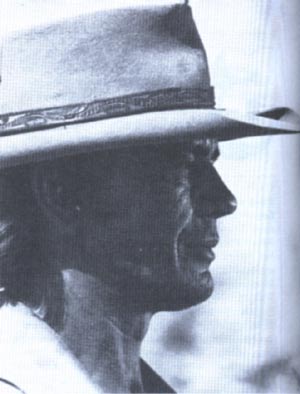Chapter IV: 'An Ancient Race'
C`era una volta il West (Once Upon a Time in the West, 1968), as its title suggests, deliberately emphasises the Western`s basis in mythic storytelling. To achieve this, Leone and Bernardo Bertolucci (his Marxist co-writer) decided to base their tale on the myth`s received stereotypes, 'taken from the dime novel, the Wild West show, the Hollywood film, the pulp magazine, the comic-strip, rather than from American history - parts of the "fixed terminology" or "code" of the fictional genre'1 (Frayling). Leone was tackling the dynamics of the myth/reality boundary head-on in 'a postmodernist game'2 (Frayling) of cinematic quotations, and breaking away from Rome`s Cinecittà studios. Of course Leone - an erudite cinèaste - knew very well that Hollywood had been exploring the workings of the myth for years. John Ford in particular displayed a scholarly understanding of the transition from historical fact to legendary epic in The Iron Horse, Fort Apache and The Man Who Shot Liberty Valance, and the mythic impact of George Stevens`s Shane has already been discussed. Leone`s 'Hollywood' Western therefore self-consciously doffs its cap to such precedents, while all the time examining the mythic and ideological power behind such readily recognisable motifs as Monument Valley, the progress of the railroad, family vengeance and the twilight of the 'Old West.'
Al Muloch, Jack Elam, Charles Bronson and Woody Strode echo, and subvert, High Noon.
Leone`s intention to arouse audience familiarity with the Western`s previous conventions is realised at the very beginning of the film. Three men await their destiny with Zen-like patience at a train station, immediately evoking the drawn-out anticipation of Frank`s arrival in High Noon. On top of this, the grizzled gunman being bothered by a fly is played by Jack Elam - 'a portrait drawn from a thousand movie memories'3 (Richard Jameson), and the face of menace in so many fifties and sixties Westerns such as Vera Cruz (1954) and The Comancheros (1961) - while one of his companions is Woody Strode - John Ford`s Sergeant Rutledge (1960). Leone`s tale of a whore with a heart of gold, a lone avenger, a romantic bandit and a child-killing villain is framed by often ironic re-enactments of iconic Western scenes. So, little Timmy McBain goes hunting with his father, just as little Joey Starrett does with his father Joe in Shane. The McBain massacre echoes The Searchers with its omens of impending doom (sage hens fleeing, cicadas going silent, wind picking up) while the McBain funeral is a visual reference to the funeral of Elisha Cook Jr`s farmer, again in Shane. Later, the auction scene in The Man Who Shot Liberty Valance is echoed, but the most potent use of previous conventions is in the casting of Henry Fonda - the kindly face of humanity in so many Westerns - as Frank, the sadistic child-killer. As the villain`s face is revealed, Leone intended the audience to yell 'Jesus Christ, it`s Henry Fonda!'4 These and many other Western citations too numerous to list allowed Leone to explore the machinery of the myth from within Hollywood`s conventions, by borrowing its cherished clichés and manipulating their ideologies. He admired Ford, but disagreed with his sentimentality, and his belief 'in the green prairies extending into the future. Me, I`m a Roman, therefore fatalistic and pessimistic.'5 Bertolucci and Leone present another grim vision of progress here, with a biting critique of 'manifest destiny.'
'Jesus Christ, it`s Henry Fonda!'
When Frank`s gunshot has exterminated the innocent child his gun barrel immediately merges with a steam train in metonymic montage, and the tone of Once Upon a Time in the West is set. The railroad, a synecdoche for 'progress' itself, is a brutal harbinger of misery, run by a symbolically diseased capitalist and enforced by a malicious and psychotic gunslinger. Once again, we see 'little people' persecuted and cajoled, trapped in Leone`s West of economic cruelty. Wobbles, Frank`s informant, is beaten by Harmonica then, hopelessly out of his depth, killed by his employer; the town of Flagstone is terrorised by Frank`s gang at the auction (echoing Shinbone`s fear of Liberty Valance) and the elderly railway ticket man - a slave to progress - is intimidated by Jack Elam`s menace (just as the train guard in For a Few Dollars More dared not question Mortimer). Paul Starrs writes that Once Upon a Time in the West is a visual homage to Mao Tse Tung`s adage 'political power grows out of the barrel of a gun,'6 but Frank`s infanticidal bullet is loaded with metaphorical resonance, and the old ways of gun lore are dying in this film. Morton, the railway magnate, knows very well that the only weapon more powerful than a Colt is the dollar, and he demonstrates this with his special 'poker deck' of one hundred dollar bills used to bribe Frank`s men. As Morton`s tuberculosis of the bones creeps through his body, so the railroad creeps ever further into the 'Old West.' Morton, the snail in his iron horse shell, leaves a filthy slime of 'two beautiful shiny rails' behind him, as he infects the West with the terminal disease of progress. Leone is back with Walter Benjamin, constantly at pains to combat complacent acceptance of progress as an ennobling and irresistible process. By emphasising the deception inherent in 'necessary' violence, he is dismantling the established codes of the dominant, 'Hollywoodised,' ideology, from within its own frame of reference - an epic 'iron horse' railroad saga, narrating the passing of the 'Old West,' since economic brutality is not the only result of progress. Once Upon a Time in the West laments the dying breaths of a nobler, mythical world, just as Hollywood`s Westerns were from the outset full of nostalgia for a lost golden age. Where Hollywood showed the onset of technology as an essentially constructive transition, however, Leone presents a traumatic rupture in history, where the 'demi-gods'7 of his youth are mercilessly swept aside by 'a world without balls.' This somewhat misogynistic interpretation from Leone of the clean-cut 'worship of "mom"'8 that modern America represented to him is symbolised by Jill McBain (Claudia Cardinale) mothering the brave new world of rail workers as Charles Bronson`s Harmonica - the last lone rider - and the dead body of Jason Robards`s Cheyenne - the last romantic bandit - ride away. It may be that, as Cumbow writes,9 'those who dig' - the victims of Leone`s brutal West - have the last laugh over 'those with loaded guns' and go on to build a new nation, but our 'worn out stereotypes'10 are similarly killed off by the railway, which indiscriminately wipes out all connections with the mythic past. Cheyenne is in the tradition of the great heroic outlaw myths of the Old West - Billy the Kid, Jesse James, Butch Cassidy - but he, like the other stalwarts of the 'golden age' in this film, is heading for death. Casting a forty-eight year old as a romantic fugitive breaks with traditional 'live fast, die young' heroes, and the manner of Cheyenne`s death presents another overt symbol for the destruction of the West by progress - a slow, painful demise caused by a bullet in the gut from 'Mr. Choo-Choo' (Morton killing the Old West, ironically, with its own weapon - the gun - not his more powerful dollar). Harmonica`s vengeance motive and ethereal lonesome silence are ages old, but as he rides off into the landscape his cargo of death is no Eastwood-esque lucrative wagon, for he bears Cheyenne to his final resting place, and the golden age with him. As Cumbow points out, the apparent 'slowness' of the film betrays an odd feeling that 'time always seems to be moving too fast to suit Leone and his dying race of titans.'11 Harmonica knows it, telling Frank 'time sure flies,' and all the clocks in the film are either handless or stopped. Cheyenne`s tragic inability to adapt to the new world is shown when he appears to 'ride' Morton`s train, using a toilet flush as a stirrup, and the iron horse steadily overtakes the four legged horse as the film progresses. Even Frank, with his ambitions of capitalistic domination, rides a horse until the very end, when he too discovers that he is not a businessman after all - 'just a man,' and Harmonica stamps a seal on their dying breed - 'An ancient race.' As we have seen before, however, Leone does not merely undermine Hollywood`s myths - he builds his own, and Once Upon a Time in the West is more than a Marxist critique of progress. Having conquered Hollywood`s territory (literally, in the Monument Valley shots), he goes about nurturing his own mythic world (which has been steadily established in the previous three films) on the dismantled myth`s foundations. A break from Cinecittà studios this may be, but the Leone trademarks persist, and flourish: Morricone`s scoring is as majestic and bold as ever before, and extreme close-ups and elaborate use of wide-screen introduce drawn-out preambles to gunfire from an avenging angel whose flashback of family grievance echoes Mortimer`s, and who shoots a malevolent trio at the start and an arch villain in a corrida at the close. Harmonica is in many ways a parallel of Eastwood`s lonesome sharpshooters, but the flashes of humour are now absent, and Bronson takes the taciturn avenger figure to an extreme.
Charles Bronson's granite visage
Indeed, muteness pervades Once Upon a Time in the West. Ennio Morricone 'says' far more than do any of the characters with his beautifully rousing scores, this time composed in advance of filming. Leone played the music - a notable departure from the previous Jew's harps and grunts - on set, and timed the actors` movements as operatic choreography. The opening scene - usually a jarring credit sequence shot to pieces by pistol fire - is now slow, meditative and silent bar the creak of a windmill. The ponderous pace led to many cuts in American prints, destroying the steady rhythm of a film 'intended to create the sensation of the last gasps that a person takes just before dying'12 (Leone). It is perhaps unsurprising that fans of Leone`s previously boisterous Westerns were initially nonplussed by his masterpiece, and Andrew Sarris identifies Once Upon a Time in the West as 'essentially a silent movie.'13 Its very power lies in its mystical stillness, Jameson describing it as 'an opera in which arias are not sung but stared.'14 The central figure even plays in the orchestra - Cheyenne commenting 'Instead of talking he plays' of a man known only by his destiny-laden sound - the haunting wail of the harmonica. This 'man with no name' also answers to the names of Frank`s very dead victims, as Leone brings the strands of his myth together and the question haunting all of his films is repeated - 'Who are you?' Once Upon a Time in the West is the final, most accomplished apotheosis of Leone`s mythic fairy tale, as an overtly 'dead' ghost of vengeance pursues his nemesis into the arena of death, literally, to face his destiny (mirroring the Greek Furies` pursuit of Orestes in Aeschylus`s The Eumenides). Harmonica is shot, and arises, in the opening scene, and throughout the film he 'ghosts' into scenes with uncanny omniscience. This is the West Leone imagined in his infancy - Homeric demi-gods ('an ancient race') hovering on the point of death as a family vengeance plot as old as story-telling itself is acted out in his arid amphitheatre. The ritual that Leone constantly stressed - the corrida - is now recognised as ritual by the combatants in the conversation between Frank and Harmonica immediately preceding their date with destiny. Leone is now unmasking his myth - where previously he inserted ghost towns or miraculously removed a Civil War battlefield to empty his arena for the showdown, now Frank himself sees what is happening - 'Nothing matters now - not the land, not the money, not the woman. I came here to see you.' Harmonica has saved Frank from being killed before this face-off, similarly preparing for the appointed hour, and just as Ramon, Indio and Angel Eyes have stepped into the ring to face inevitable death, Frank acknowledges that Harmonica must reveal who he is 'Only at the point of dyin`.' Again, the moment of death is paramount, and Frank discovers (as do we) who this Fury is as he dies, the harmonica returned to him, and nods. It seems that one of the 'obstacles' on the railtrack has come back to haunt him! Cheyenne, too, makes the elements of Leone`s fairy tale explicit, observing that people like Harmonica 'have something inside, something to do with death.' Frank, Harmonica and Cheyenne himself are of a different stock - an ancient race marching headlong towards their doom, and Danny Peary writes15 that they represent a race of supermen, standing to mortals as Titans to Olympians. Poetic justice is served on Morton, who slithers, a snail out of its shell, towards a pitifully small puddle as his dreams of reaching the Pacific literally evaporate. This water, of course, springs from the ground, and is the very cause of the McBain massacre. McBain`s dream flourishes around the well that made his land so lucrative and divine justice is wreaked on the brutal vision of progress the railroad represents. Leone`s most personal
vision of the West he pictured in his childhood self-consciously confirms
his dictum: I remain convinced
that by far the greatest writer of Westerns was Homer, for he He had graduated from his early parodies, first of the ancient epic with The Colossus of Rhodes (1960), then of the Western, and applied his fascination with ancient myth to the dominant modern myth. His farewell to the Western genre was far more successful amongst European students and cinèastes than it was in America, where it was butchered in the cutting room and made only one million dollars. In retrospect, however, it has come to be seen as the masterpiece it is, Jameson bestowing this honour on it in 1973: 'Along with Kubrick`s Space Odyssey, Once Upon a Time in the West is one of the two great visionary/mystical films of the sixties.'17 Not everybody had such praise for Leone`s final Western, however - Wim Wenders called it 'the end of a craft […] (the death) of a genre and of a dream. Both of them American,'18 and this brings us back to the argument that Americans alone have a 'birthright' to make Westerns. Charlton Heston, in his autobiography, writes that 'Americans are the only ones who can make (Westerns) […] Sergio Leone is not the exception; Clint Eastwood and Henry Fonda lent his Spaghetti Westerns what validity they had.'19 This was a common reaction to Leone`s films, reflecting a feeling of national pride in the genre, expressed by James Stewart thus: 'The Western is an original. An American feels "this is ours."'20 Even Eastwood claims that the Western, along with jazz, is one of the 'only two really authentic American art forms.'21 This school of thought generally views non-American Westerns as copies of Hollywood (which some, such as the German Karl May adaptations and many pre-Leone Italian Westerns, were), and Walter Clapham asserts them to be imitation amounting to flattery, albeit from vastly inferior films. This critical consensus, however, caricatured all European Westerns as one obscene mass, and more recently, Leone`s work has been given its due, above the general flotsam and jetsam, Christopher Frayling, Robert Cumbow, Laurence Staig and Tony Williams being among the most notable critics to redeem his reputation. To my mind, claims
that the Western is by right American are at best base and arrogant,
at worst reactionary and downright racist. Leone made his position
on the matter abundantly clear: America was
something dreamed by philosophers, vagabonds and the wretched of Leone here identifies the real crux of the issue - America`s roots are in European culture. Frayling effectively destroys the anti-Leone argument by pointing out23 that John Ford was Irish, and that to ignore the influence of immigrants on American culture is to misunderstand how the component parts of myth are constructed, and Sarris argues that 'Leone is no further from the legends of the American West than the Florentine Renaissance painters were from the crucifixion.'24 This analogy returns me to Leone`s interpretation of myth. Once Upon a Time in the West is a paradigm for Leone`s overall achievement in redefining the Western myth - after initially examining the traditional codes of the genre through quotation or parody, he dismantles their ideologies, exposing the primal roots of mythic storytelling that have always been at the heart of the Western. The skeleton of popular myth has been there all along, covered by the atrophying blubber of historically specific Frontier ideology. Leone has skinned the allegedly American myth alive (removing the veneer of WASP culture and its emphasis on ennobling, 'necessary' violence for a greater cause), and dressed the bare bones in the garb of the pupi Siciliani, of Homer and of his childhood fantasies. As early as 1902, Frank Norris saw in the Western myth an affinity with Norse sagas25, and Owen Wister likened the cowboy to the knights of Sir Thomas Malory26. Revenge, family feuds and nostalgia for pastoralism have been staples of popular myth throughout human history, and it is a mistake to believe that the latest ideological façade to adopt such themes is the myth, even more to claim a national birthright to it. Saying an Italian cannot make Westerns because he is not American is like saying Shakespeare cannot write tragedy because he is not from ancient Greece, a point that was not lost on Leone: 'William Shakespeare could have written some great Westerns.'27 Finally, Frayling
points out28 a link between Leone's Westerns
and Roland Barthes`s Mythologies. Barthes writes that bourgeois
society attempts to conceal its ideologies behind mythical codes by
presenting them as 'natural' concepts (Benjamin's 'historical materialism'
again applies). These codes therefore perpetuate bourgeois ideology
and are inherently resistant to being exposed. This describes perfectly
the criticisms of Leone from Western purists who were, perhaps unwittingly,
displaying reactionary attempts at perpetuation of WASP Frontier culture. Footnotes1. Frayling, Spaghetti Westerns,
p.194. |

